Quiet red sandstone cliffs frame a bustling ribbon of trails, and you’ll find both solitude and activity here. You’ll want to plan around seasonal hours and fees, pick trails that match your fitness, and know when to watch for wildlife or flash floods. This guide gives practical tips on hikes, picnic spots, accessibility, and safety so you can make smart choices before you head into the park.
Planning Your Visit and Park Hours
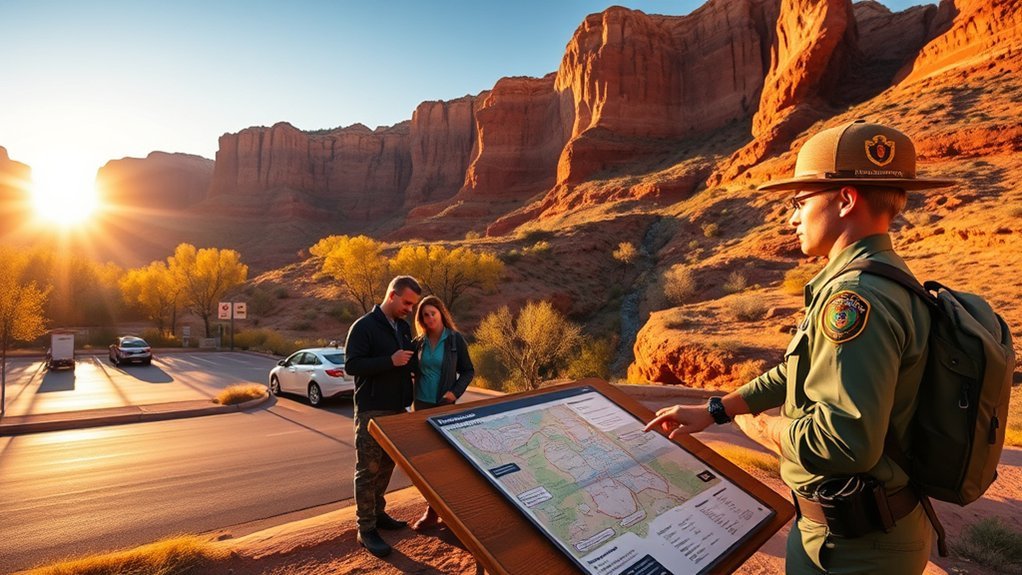
Before you head out, check the park’s seasonal hours and any special alerts so you won’t arrive after gates close or during a temporary trail closure. You’ll plan around peak times — mornings and late afternoons are busiest — and consider weekday visits to avoid crowds. Confirm park entry fees and payment methods online so you won’t be delayed at the gate. When you arrive, stop by the visitor center to pick up maps, current conditions, and advice from staff who know local wildlife activity and weather shifts. Pack water, sun protection, and layered clothing for temperature changes. Have an alternate plan if popular areas are full, and note restroom locations and parking limits to make your visit smooth and enjoyable.
Top Trails and Hiking Tips
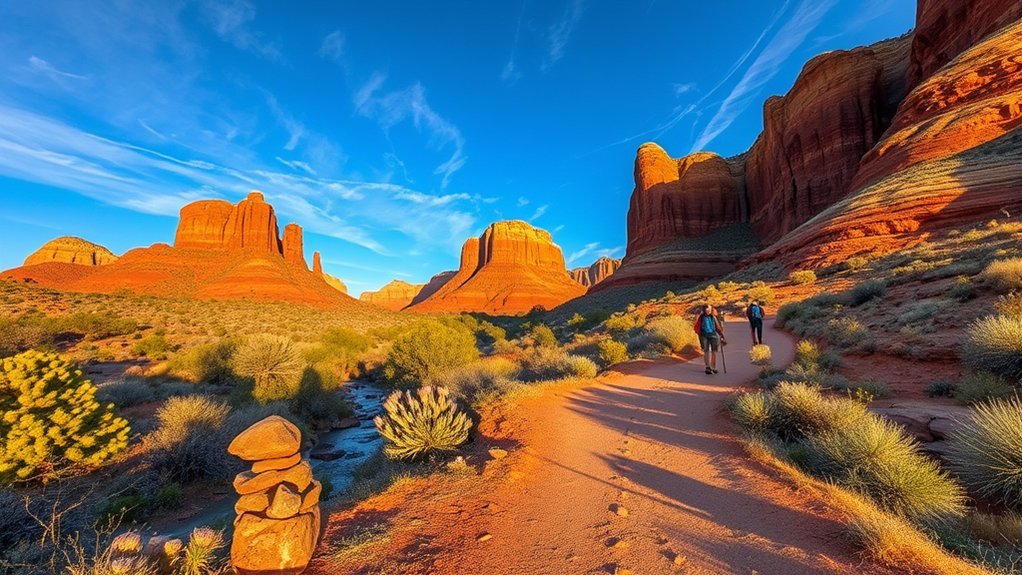
You’ll find a handful of standout trails at Red Rock State Park, from easy creekside strolls to steeper ridge routes that reward you with sweeping red-rock views. Before you head out, check trail lengths and elevation so you can pick one that matches your fitness and time, and pack layers, plenty of water, sun protection, and sturdy shoes. Stay on marked paths, watch for changing weather, and tell someone your route so you can enjoy the scenery safely.
Best Trails Overview
Wondering which Red Rock State Park trails give you the best combination of views, geology and wildlife? You’ll find a mix of trail types: easy boardwalks that skirt riparian habitats, moderate singletrack winding through red sandstone fins, and longer loop trails that climb for panoramic scenic views. Start with short interpretive routes to learn geology and spot birds, then tackle the Cathedral or Eagle’s Nest paths for dramatic overlooks and layered rock formations. Look for connectors that blend solitude with accessible vistas; they often reward you with quiet wildlife sightings. Time your hike for softer light and fewer people. Pace yourself, hydrate, and stay observant—these trails reveal more the slower you move, letting geology and fauna guide your experience.
Safety and Gear Tips
After you’ve picked the trails that match your interests, gear and safety habits make the outing rewarding rather than risky. You’ll want sturdy shoes, layered clothing, sun protection, and a compact first aid kit—know how to use each item before you need it. Check weather and trail conditions, tell someone your route, and carry physical maps alongside your phone for navigation tips when signal fails. Stay hydrated and pace yourself on steep sections.
- Pack: water, snacks, first aid, map, headlamp.
- Dress: layers, hat, durable shoes, rain shell.
- Practice: route planning, basic first aid, compass use.
Follow park rules, respect wildlife, and turn back if conditions worsen.
Wildlife, Plants, and Geology Highlights

When you explore Red Rock State Park, keep your eyes and ears open for a rich mix of wildlife, plants, and striking geological features that define the landscape. You’ll spot mule deer, jays, and occasionally bobcats along riparian corridors; bring binoculars for focused wildlife observation. Trails pass through juniper, pinyon, and cottonwood stands—practice plant identification to distinguish resinous pinyon from smooth-barked cottonwood. The layered red sandstone cliffs, carved by Oak Creek, show cross-bedding and ancient dune structures; you can read erosion patterns and fault lines in exposed outcrops. Listen for bird calls, watch for tracks near stream edges, and note seasonal wildflowers carpeting meadows. Respect habitats, stay on trails, and leave geological and botanical features undisturbed.
Picnic Areas, Camping Options, and Nearby Dining
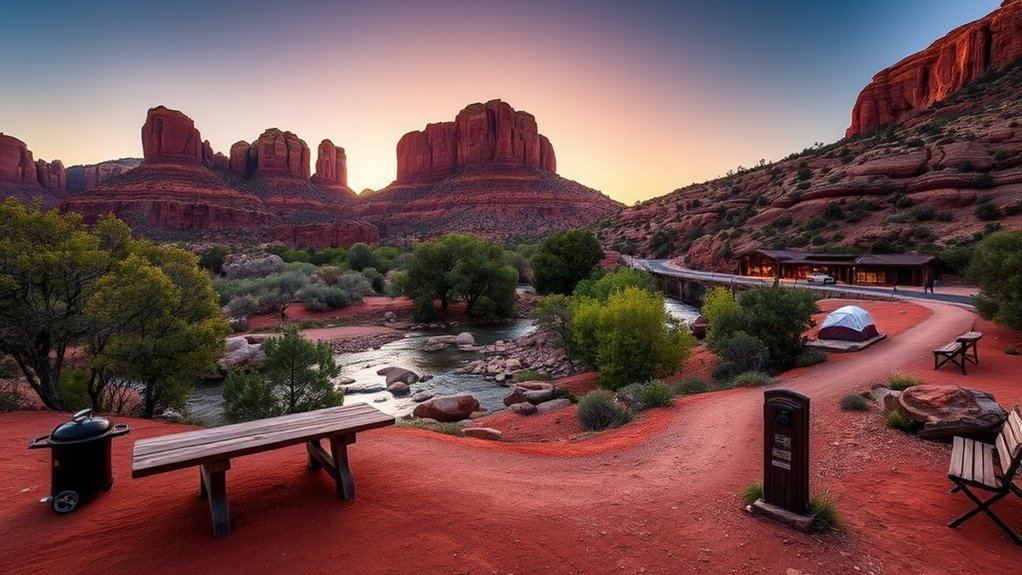
If you’re planning a visit, the park’s picnic areas make it easy to relax amid red-rock views and riparian shade; several family-friendly tables and grills sit near the Oak Creek corridor, while quieter spots tucked under cottonwoods offer more solitude. You’ll find vault toilets nearby and flat, shady ground for spreading a blanket. Bring picnic essentials: reusable utensils, a cooler, trash bags, and sunscreen. Camping is limited—stick to nearby state and private campgrounds that offer tent sites and hookups; check reservations in advance. For dining recommendations, head into Sedona for diverse options or try casual cafes just outside the park. Consider these quick tips:
- Pack out all trash and recyclables.
- Reserve campsites ahead of peak times.
- Prioritize water and shade.
Seasonal Weather, Trail Conditions, and Packing Checklist
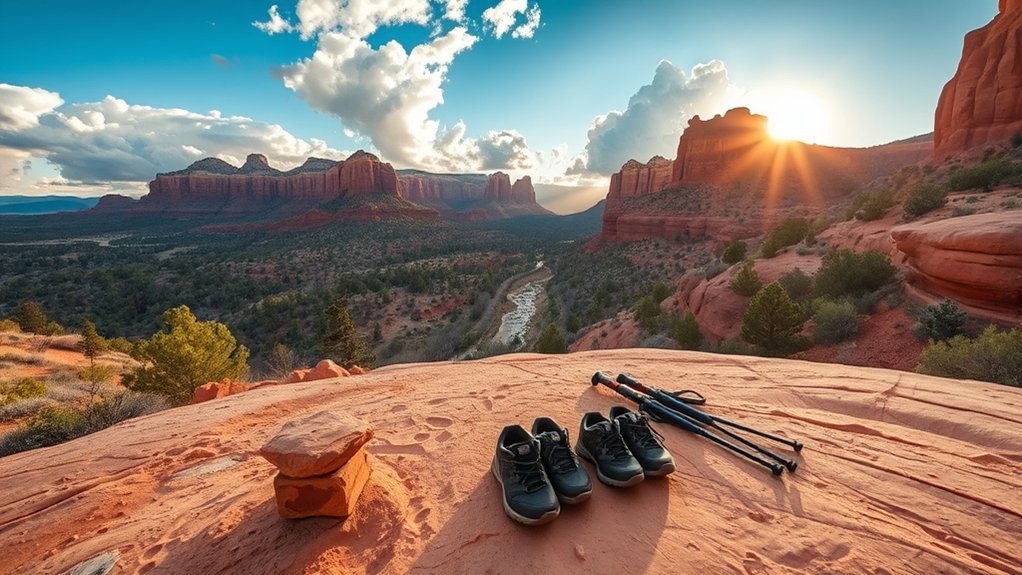
Because weather in Red Rock State Park shifts quickly with elevation and season, you should check forecasts before you go and prepare for wide temperature swings between morning and afternoon. Pay attention to seasonal changes: spring brings sudden storms, summer heats with monsoon bursts, fall cools rapidly, and winter can bring snow at higher elevations. Trail conditions vary accordingly—muddy or icy sections after rain or thaw, loose scree on steeper slopes, and dusty, hard-packed routes in dry months. Pack layers, sturdy hiking shoes with good traction, sun protection, rain gear, and a warm hat for evenings. Carry water, snacks, a basic first-aid kit, map or GPS, and a headlamp. Adjust gear to daily weather patterns and trail reports.
Accessibility, Family Activities, and Kid-Friendly Options
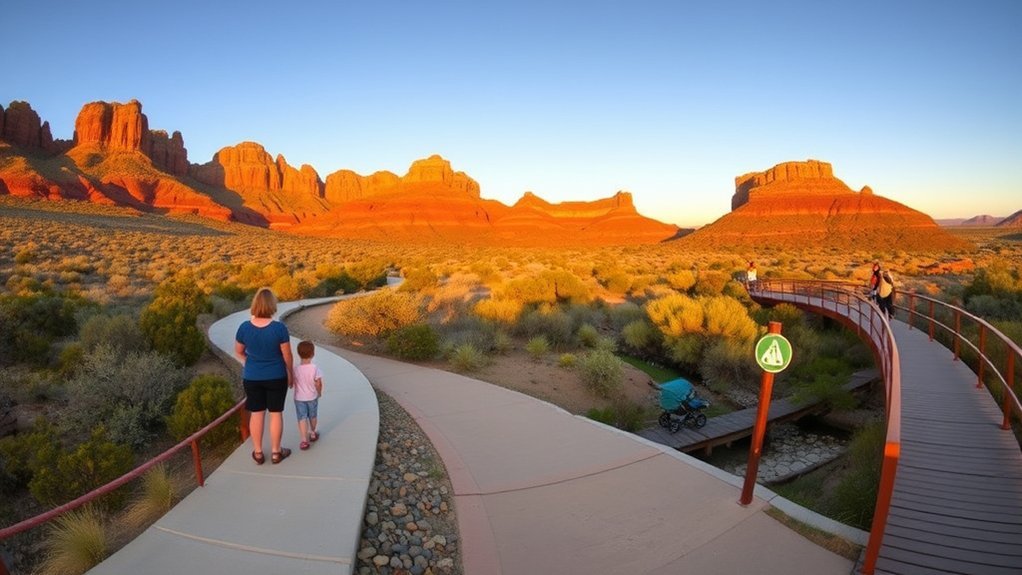
You’ll find a mix of easy, well-marked trails that work for families and a few rougher paths where strollers won’t go. Picnic areas and clean restrooms are located near the visitor center, so you can plan snack breaks without guessing. Check the park’s schedule for Junior Ranger activities and kid-focused programs that make learning about the red rocks fun and hands-on.
Trail Difficulty & Strollers
While some Red Rock trails climb steep sandstone and require sure footing, several paths are gentle and stroller-friendly so families with young children can still enjoy the scenery. You’ll find stroller friendly trails noted on the park map; choose routes with firm, even trail surface types like packed dirt or boardwalks. Steeper or rocky sections call for baby carriers rather than wheels.
- Check elevation changes and length before you go.
- Match your stroller to the surface — large wheels for gravel, compact for paved segments.
- Bring sun protection, water, and a light rain cover for sudden weather shifts.
You’ll stay safer and more comfortable if you plan ahead and pick trails that suit your gear and skills.
Picnic Areas & Restrooms
Anyone can find comfortable spots to eat and relax at Red Rock State Park—picnic tables, shaded pavilions, and grassy areas are scattered near trailheads and the visitor center, and restrooms (including accessible stalls) sit close to the main gathering areas. You’ll appreciate accessible routes to tables and family-friendly spaces where kids can play nearby while you supervise. Follow simple picnic etiquette: pack out trash, secure food from wildlife, and leave benches clean for the next group. Restroom facilities are maintained and clearly signed; bring hand sanitizer if you plan remote trails. Below is a quick at-a-glance guide to help you plan.
| Area | Notes |
|---|---|
| Visitor Center | Closest restrooms |
| Oak Picnic Area | Shaded, grills |
| Creekside Lawn | Open play space |
| Pavilion A | Reservable |
| Trailhead Tables | Quick access |
Junior Ranger & Programs
Because kids learn best when they’re hands-on, the Junior Ranger program at Red Rock State Park mixes short, guided activities with self-led badge tasks so your family can pick what fits your pace and abilities. You’ll find Educational Programs scheduled seasonally—ranger talks, nature walks, and creek ecology sessions—designed for different ages and mobility levels. Facilities are mostly accessible; ask at the visitor center for adaptive tools or quieter program times. Bring water, sun protection, and layered clothes for comfort. Volunteers and staff are friendly and offer tips to engage hesitant kids.
- Choose a short program to test interest.
- Combine self-led badge tasks with a ranger walk.
- Use accessible routes for stroller or wheelchair access.
Rules, Permits, and Leave No Trace Guidelines
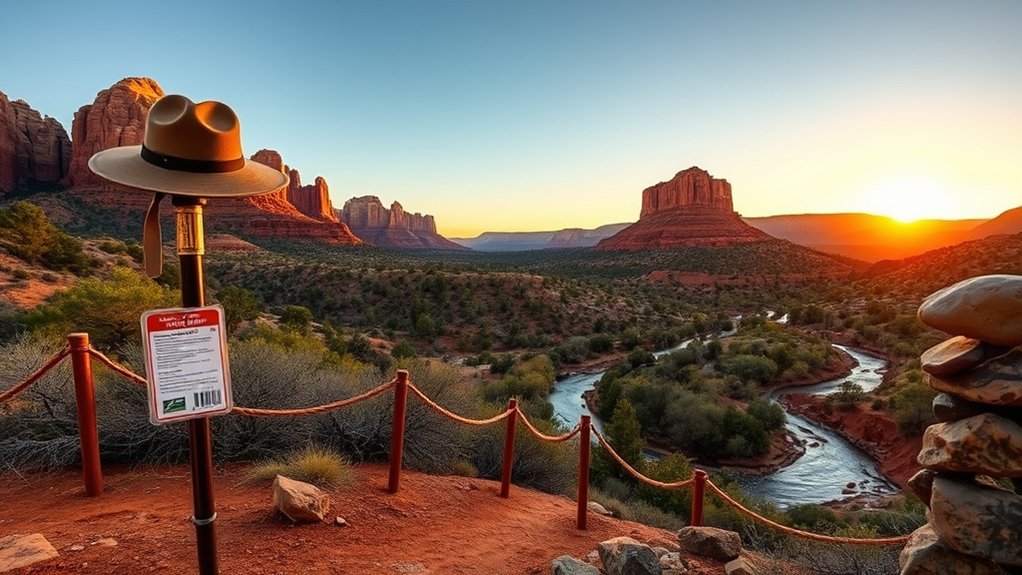
Before you set out on the trails or picnic areas, know the park rules and required permits so you can enjoy Red Rock responsibly and avoid fines or closures. You’ll follow park regulations like staying on designated paths, leashing dogs, and observing seasonal trail closures to protect wildlife and fragile soils. Permits are required for group events, commercial guiding, and some special-use activities — check the visitor center or website before planning. Practice responsible recreation: pack out trash, avoid picking plants or artifacts, and minimize noise. Use established campsites where allowed and dispose of waste properly. Leave No Trace isn’t just etiquette; it’s practical stewardship that keeps views pristine and habitats healthy for future visitors.
Frequently Asked Questions
Are Drones Allowed Anywhere in the Park?
No, you can’t fly drones anywhere in the park; drone regulations prohibit recreational flights in many areas. You’ll need a permit and must follow rules for aerial photography, respecting wildlife, visitor safety, and designated no-fly zones.
Is There Cell Phone Reception on Major Trails?
You’ll find limited cell coverage on major trails, so don’t rely on it. For trail safety, carry a map, tell someone your route, pack water and a charged power bank to stay connected in patchy areas.
Can I Bring My Dog on Guided Tours or Shuttle Services?
Yes — you can bring dogs on some guided tours and shuttles, but policies vary; you’ll need to follow pet etiquette, keep pets leashed, and choose dog friendly activities to guarantee safety and minimize disturbance for others.
Are There Seasonal Road Closures to the Park Entrance?
About 10% of regional roads close seasonally; you’ll usually find seasonal access limited in winter, but park hours mostly remain unchanged. Check alerts before visiting so you’ll avoid surprises and plan your trip confidently.
Is Fishing Permitted in Park Waterways?
Yes, you can fish in park waterways, but you’ll follow fishing regulations and seasonal restrictions; you’ll encounter local fish species like trout and bass, so check license requirements, catch limits, and gear rules before casting.
Conclusion
You’ve planned your route, packed your water, and checked the hours; now step onto rust-red trails, listen for jay calls, and watch sunlight carve sandstone into shadows. You’ll spot rabbit tracks, trace ancient layers, and pause at a picnic bench to breathe. You’ll follow signs, respect wildlife, and carry out your trash. Enjoy the views, savor the silence, and leave the park ready for the next curious visitor.

